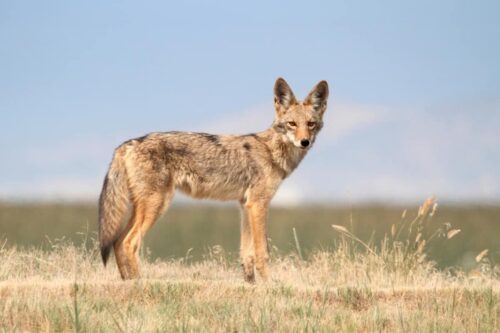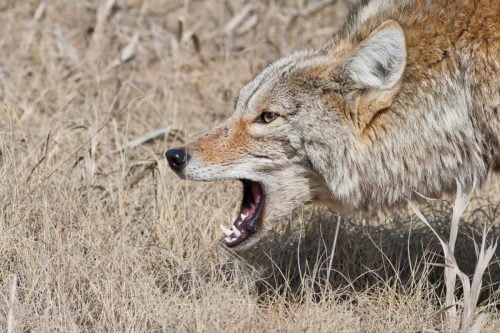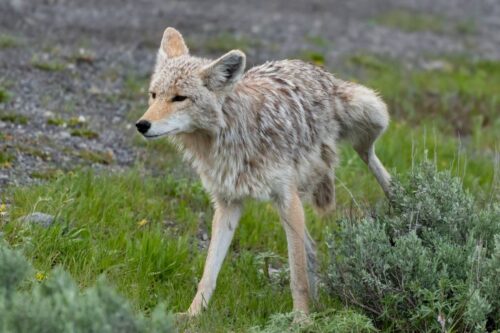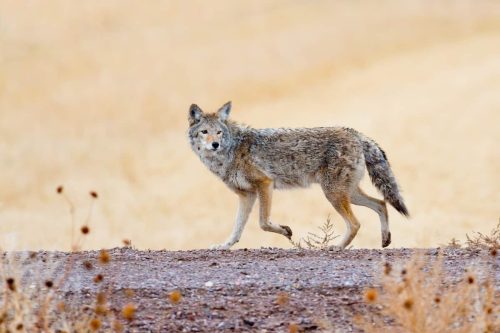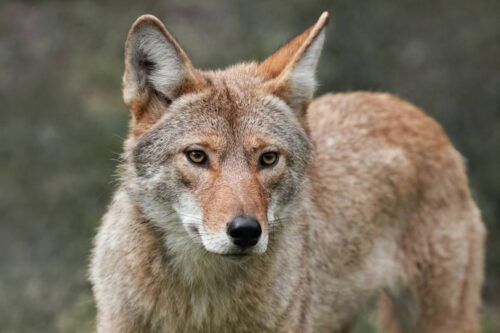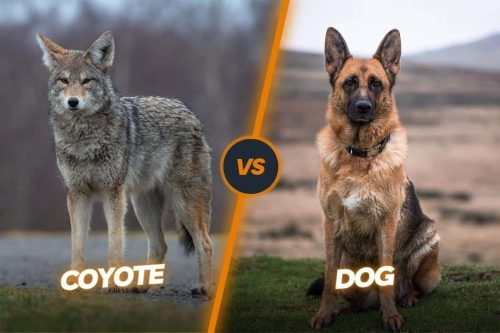How To Trap A Coyote: Let’s explore Baiting for coyotes
So, you got yourself a pesky coyote problem, huh? Those crafty canines are giving you a run for your money, raiding your chicken coop, or disrupting the peace of your homestead. Fear not! We’ve got the lowdown on how to outsmart these wily creatures and put an end to their mischief-making.
In this high-octane guide, we’ll show you unconventional and human-like ways to set a coyote live trap effectively. You won’t find any snooze-worthy, repetitive advice here – just bold and inventive strategies to help you get the job done. So grab your cowboy hat, strap on your boots, and let’s hit the trail to learn how to trap a coyote like a real prolling the legalities and ethics of trapping.

Contents
- What is a coyote & why is trapping necessary?
- Understanding Coyote Behavior to Trap it Faster
- Preparing for Trapping a Coyote
- Responsible Coyote Trapping Practices
- Avoiding Non-Target Animals in Coyote Trapping
- Strategies for Reducing Unintended Captures
- Dealing with Trapped Coyotes
- Properly Euthanizing or Releasing Captured Coyotes
- Ethical and Ecological Impact of Trapping Coyotes
- Alternatives to Trapping
- Conclusion
- FAQs
What is a coyote & why is trapping necessary?
Coyotes, members of the canine family, are highly adaptable and intelligent creatures that inhabit various regions across North America. While they play a crucial role in the ecosystem by controlling rodent populations, their presence near human settlements can sometimes lead to conflicts. In such situations, trapping coyotes becomes necessary to ensure the safety of both humans and wildlife. However, setting traps for coyotes is not as easy as it sounds.
This article aims to guide you on how to trap a coyote effectively and ethically, considering the importance of responsible wildlife management.
Understanding Coyote Behavior to Trap it Faster
Before attempting to trap a coyote, it’s essential to familiarize yourself with their behavior. Coyotes are primarily nocturnal animals that roam vast territories in search of food. They are opportunistic omnivores, with a diet consisting of small mammals, birds, fruits, and carrion. Identifying signs of coyote presence, such as tracks, scat, and vocalizations, can help you choose the best trapping locations.
Preparing for Trapping a Coyote

Coyotes, with their adaptable and intelligent nature, often find themselves in close proximity to human settlements. In situations where their presence poses potential conflicts or threats, trapping becomes a necessary measure to ensure both human safety and wildlife conservation. However, before embarking on any trapping endeavor, it is crucial to be well-prepared and knowledgeable about the process. You shall also be sure how to locate coyotes before you set the trap. This section outlines essential steps for preparing to trap a coyote responsibly and ethically.
Researching Local Regulations
The first step in preparing for coyote trapping is conducting thorough research on local regulations and laws. Different regions may have specific rules governing trapping activities, including designated trapping seasons, trap types allowed, and permitted locations. By familiarizing yourself with these regulations, you ensure compliance with the law and contribute to responsible wildlife management. Local wildlife management authorities, conservation organizations, or official websites can provide valuable information on the legal aspects of coyote trapping in your area.
Also, read about the rules of hunting coyotes in Wisconsin.
Choosing the Right Trapping Method
Selecting the appropriate trapping method or how to make coyote bait is crucial for a successful and humane capture. Various trapping techniques exist, each with its own advantages and considerations. Commonly used methods include foothold traps, snares, and cage traps. Each method has its strengths and limitations, and it’s essential to choose one that aligns with your goals, local regulations, and ethical principles. If you are uncertain about which trapping method to use, consulting with experienced trappers or wildlife experts can provide valuable insights and guidance.
Assembling Necessary Tools and Equipment for Coyote Trap

Once you have identified the trapping method that suits your needs, it’s time to assemble the necessary tools and equipment. This is the most important part of coyote trapping tips. A well-prepared trapping kit increases the efficiency and safety of the trapping process. The following coyote bait for trapping aspects are essential items to include in your trapping arsenal:
1. Traps: Select high-quality traps specifically designed for coyote trapping. Choose traps that are appropriate for the intended method and comply with legal requirements. You can also use homemade coyote live traps but we would not recommend them.
2. Baiting for coyotes and Lures: When preparing to trap coyotes, keep in mind that they are attracted to a variety of scents, including meat-based baits and commercial lures. Proper coyote bait selection can significantly impact the success of your trapping efforts.
3. Trap Setters: These tools help set coyote trap bait effectively and safely, minimizing the risk of injury during the process.
4. Gloves: Wear protective gloves to mask human scent and avoid transferring it to the traps or bait, which could deter your coyotes’ trapping strategy.
5. Anchors and Stakes: Securely anchor traps to prevent captured animals from escaping or dragging the traps away.
6. Camouflage and Cover: Disguise traps and make them blend into the surroundings to reduce the chances of coyotes detecting them.
7. Safety Equipment: Personal safety should always be a priority. Equip yourself with protective gear, including sturdy boots, eye protection, and clothing suitable for the environment.
8. Transportation and Handling Gear: Prepare a secure and safe container for transporting any trapped coyotes. Handling equipment should be designed to minimize stress and potential injuries to the animals. No need to mention you shall also know about the best time of day to hunt coyotes.
By assembling a well-thought-out trapping kit and ensuring you have all the necessary equipment, you set the stage for a more efficient and effective trapping process. In addition to these there are also some more guidelines regarding responsible trapping for coyotes, let us discuss these one by one.
Responsible Coyote Trapping Practices

As mentioned previously, getting ready for how to trap coyotes can be a necessary measure for wildlife management and human safety, but it must be approached with responsibility, compassion, and ethical considerations. Implementing responsible trapping practices ensures that the process is conducted humanely, with minimal harm to the animals involved. It is highly recommended that you shall use the best coyote trap for that purpose. This section outlines three key aspects of responsible coyote trapping practices.
Also, read about coyote spirit animal to learn the importance of coyotes in different cultures.
Humanely Trapping Coyotes

Humanely trapping on coyotes is of paramount importance. It involves using traps and techniques that minimize pain and stress to the animal. Modern trapping methods have evolved to include advanced designs that reduce the risk of injury, making them more humane than older, more indiscriminate traps.
Foothold traps, for instance, are designed to hold the animal’s foot securely without causing significant harm. It is considered to be the best trap for coyote capturing. Additionally, padded traps and trap modifications can further enhance the welfare of trapped animals. Trappers should regularly check traps to prevent extended periods of stress for the animal and should avoid setting traps in extreme weather conditions to ensure the animal’s well-being.
Handling Trapped Animals Compassionately
Once a coyote is trapped, it is crucial to handle the animal with care and compassion. Approach the trapped animal cautiously to avoid causing unnecessary distress. Wear protective gloves to minimize the transfer of human scent, which could alarm the coyote. Keeping the trapped animal calm and stress-free is essential for the well-being of both the animal and the trapper.
In situations where relocation or release is a viable option, handle the coyote carefully during transportation. Use appropriate handling equipment and ensure a safe, suitable release site far from human settlements. It is crucial to minimize any negative impact on the animal’s natural behavior and ability to survive in its new environment.
Knowing When to Seek Professional Help
Responsible coyote trapping also involves recognizing when the situation calls for professional expertise. Trapping and handling wildlife can be challenging and potentially dangerous, especially for individuals without prior experience. If a trapper finds themselves unsure about proper trapping techniques, handling methods, or the legal aspects of trapping, seeking guidance from trained professionals or wildlife experts is essential.
Wildlife professionals have the expertise to address challenging trapping scenarios and can ensure that the trapping process aligns with local regulations and ethical standards. Moreover, professional trappers have access to specialized equipment and knowledge of coyote behavior, allowing for a more effective and humane trapping process.
Avoiding Non-Target Animals in Coyote Trapping
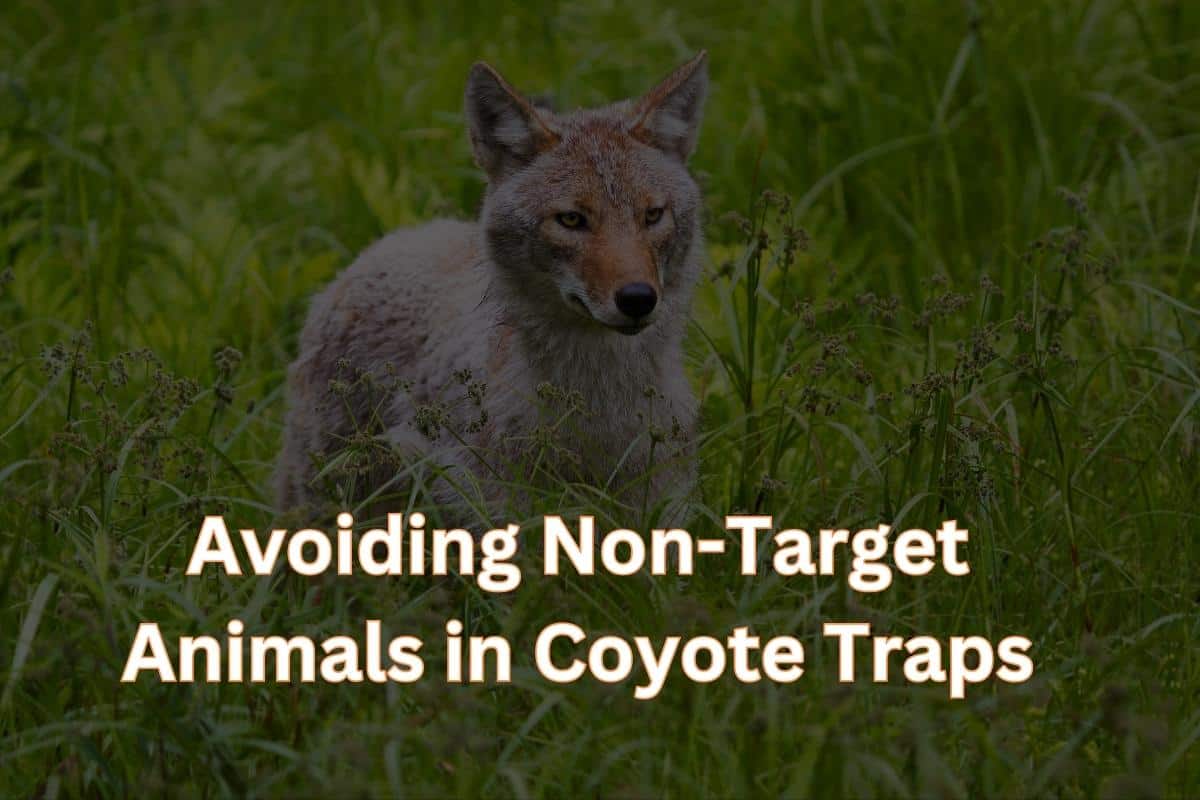
When engaging in coyote trapping, it is crucial to consider the potential risk of unintentionally capturing non-target animals. Non-target captures can lead to distress and harm to other wildlife species, and it is the responsibility of trappers to minimize these unintended consequences.
Implementing Methods to Avoid Catching Non-Target Species
This section discusses effective methods to avoid catching non-target animals and strategies for reducing unintended captures during the coyote trapping process. For that, you shall also be sure about what attracts coyotes.
Selective Trapping Locations:
Choose trapping locations strategically to minimize the chances of catching non-target animals. Avoid placing traps in areas with high non-target species activity, such as near bird nests or den sites of other wildlife.
Use Size-Specific Traps:
Employ traps that are specifically designed to target coyotes based on their size and avoid using traps that are likely to capture smaller animals unintentionally.
Set Trap Timers:
Use time-sensitive mechanisms or set timers on traps to prevent long periods of trapping when non-target species are more active, reducing the likelihood of catching unintended animals.
Elevate Traps:
Elevating traps off the ground can prevent capturing small mammals or ground-dwelling creatures that may trigger the trap while trying to investigate the baiting for coyotes.
Strategies for Reducing Unintended Captures
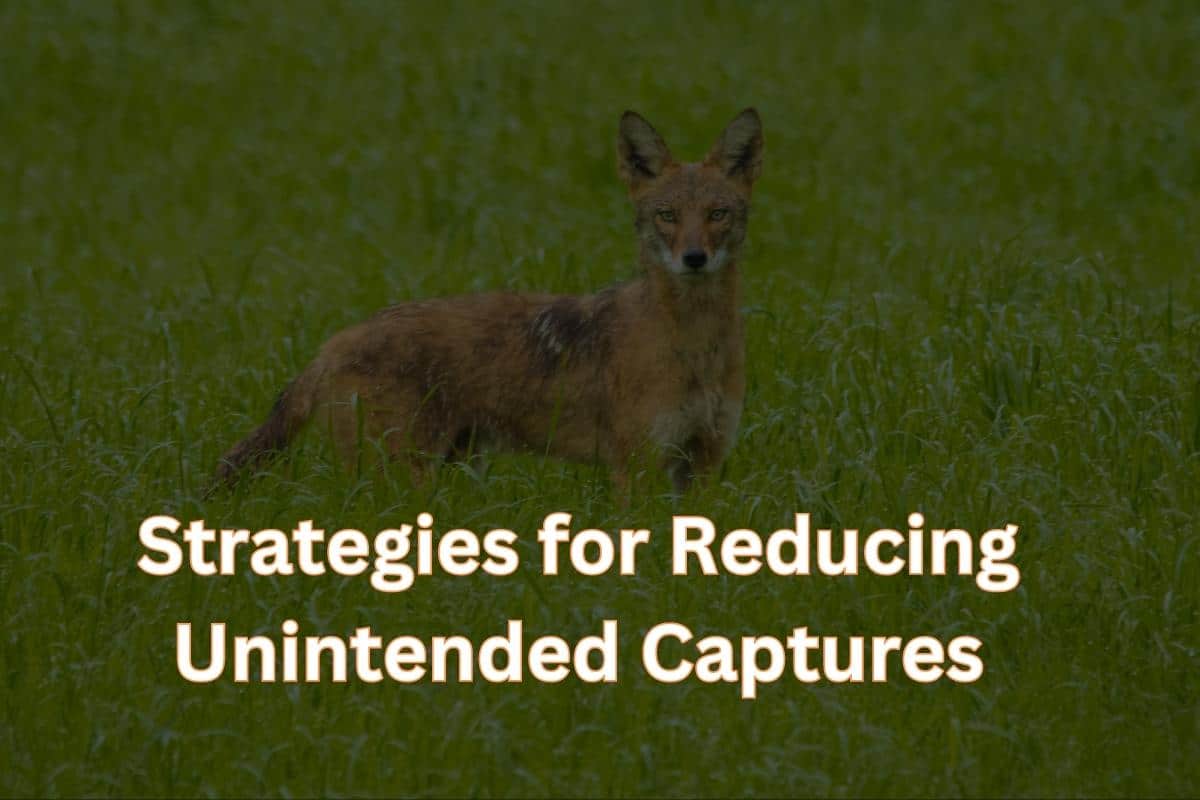
In addition to the above, you must follow specific self-educational tactics that will not only help you but also play a role in saving the other wildlife community from potential danger.
Educate Yourself:
Familiarize yourself with the local wildlife and their habits to understand which species are likely to be present in the trapping area. Knowing the wildlife in the region can help you make informed decisions on trap placement.
Use Distinct Coyote Bait and Lures:
Opt for baiting and lure options that are attractive to coyotes but less appealing to non-target species. Understanding the preferences and dietary habits of various animals can help tailor your bait coyote choices.
Camouflage Traps:
Conceal traps to blend in with the environment, making them less conspicuous to non-target species. Camouflaging traps can reduce the chances of animals stumbling upon them accidentally.
Monitor Traps Regularly:
Check traps frequently to release any non-target animals promptly. Prompt monitoring minimizes the stress and potential harm experienced by unintended captures. That is the most important aspect of how to bait coyotes.
Adopt Remote Monitoring:
Consider using modern technology, such as trail cameras or remote monitoring systems, to assess the activity around traps. Remote monitoring can provide valuable insights on non-target species’ presence and behavior in the trapping area.
Use Exclusion Devices:
Employ exclusion devices or one-way gates in front of traps to prevent non-target species from accessing the trap while still allowing targeted coyotes to approach.
Modify Traps for Specific Targets:
Adapt traps with modifications that cater to the size and behavior of the intended target species while reducing the chances of capturing non-target animals.
Understand Seasonal Patterns:
Be aware of seasonal variations in wildlife activity and adjust trapping practices accordingly to avoid unintended captures during specific times of the year.
Dealing with Trapped Coyotes

Successfully trapping a coyote marks only the beginning of responsible wildlife management. Once a coyote is trapped, it is essential to handle the situation with care, compassion, and adherence to ethical principles.
Transporting Trapped Coyotes Safely
When transporting a trapped coyote, ensuring its safety and minimizing stress is paramount. Follow these guidelines for safe transportation:
Secure Transport Container:
Use a secure and sturdy container, such as a transport cage or carrier, to prevent escape or injury to the coyote during transit. Ensure the container is well-ventilated and large enough for the animal to stand and move comfortably.
Minimize Human Contact:
Limit direct interaction with the trapped coyote to reduce stress and prevent potential injuries. Use a long-handled pole or release mechanism to avoid direct contact when opening the trap.
Keep Calm and Quiet:
Maintain a calm and quiet environment during transport. Loud noises and sudden movements can increase stress and anxiety in the animal.
Cover the Container:
Drape a cloth or cover over the transport container to create a dark and secure space, which can help calm the coyote during transportation.
Avoid Crowded Areas:
Choose routes and transportation times that avoid heavily populated or busy areas to minimize the coyote’s exposure to stressful surroundings.
Properly Euthanizing or Releasing Captured Coyotes
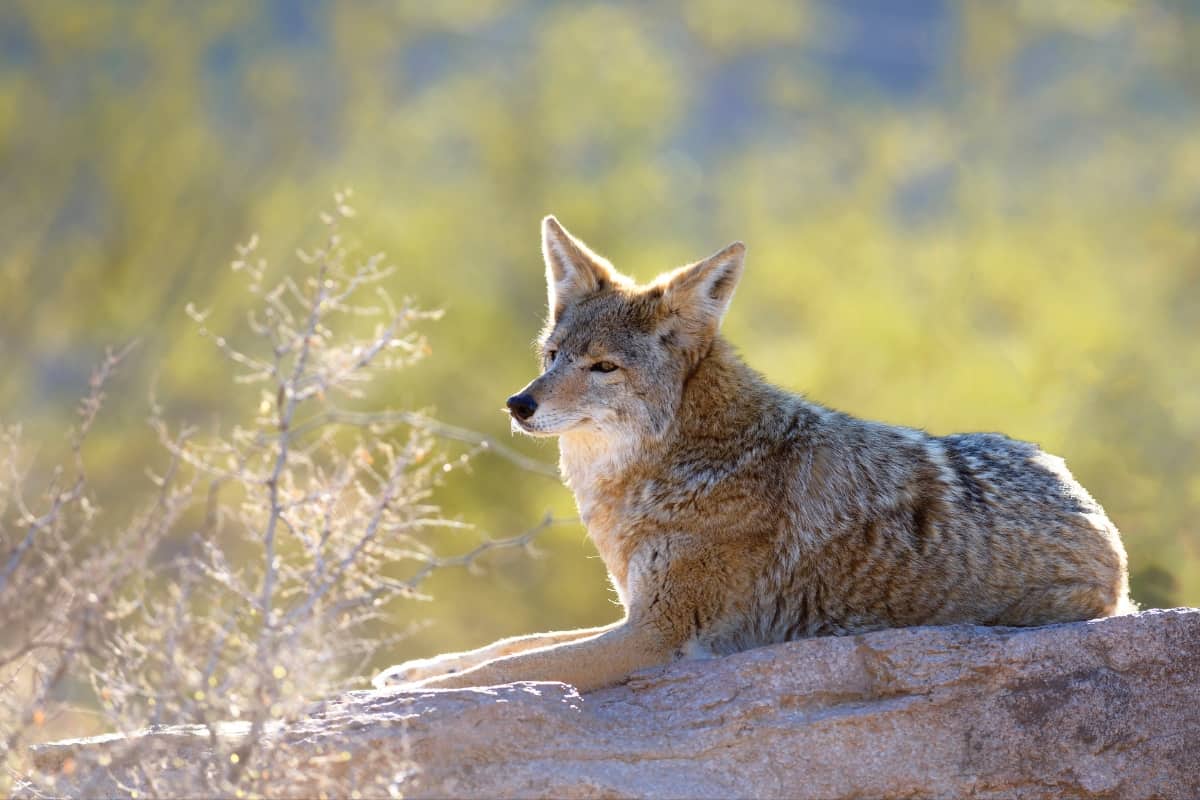
Once the trapped coyote has been transported to a suitable location, trappers must make informed decisions regarding its fate, taking into account local regulations and ethical considerations:
Euthanizing Humanely:
In situations where euthanasia is deemed necessary, it must be carried out humanely and in accordance with local laws. Trappers should be well-trained in proper euthanasia techniques to ensure the least amount of suffering for the animal.
Releasing in Suitable Habitat:
If local regulations permit, and it is determined that releasing the coyote is appropriate, choose a suitable habitat far from human settlements. Release the coyote in an environment where it can thrive and continue contributing to the ecosystem.
Consider Professional Help:
If unsure about how to proceed or if local regulations are unclear, seek guidance from wildlife professionals or conservation authorities. Professional advice can help make informed decisions that prioritize the welfare of the trapped coyote.
Document and Report:
Keep records of the trapping process and any actions taken with the trapped coyote. If required by local authorities, report the trapping and disposition of the coyote as per regulations.
Ethical and Ecological Impact of Trapping Coyotes
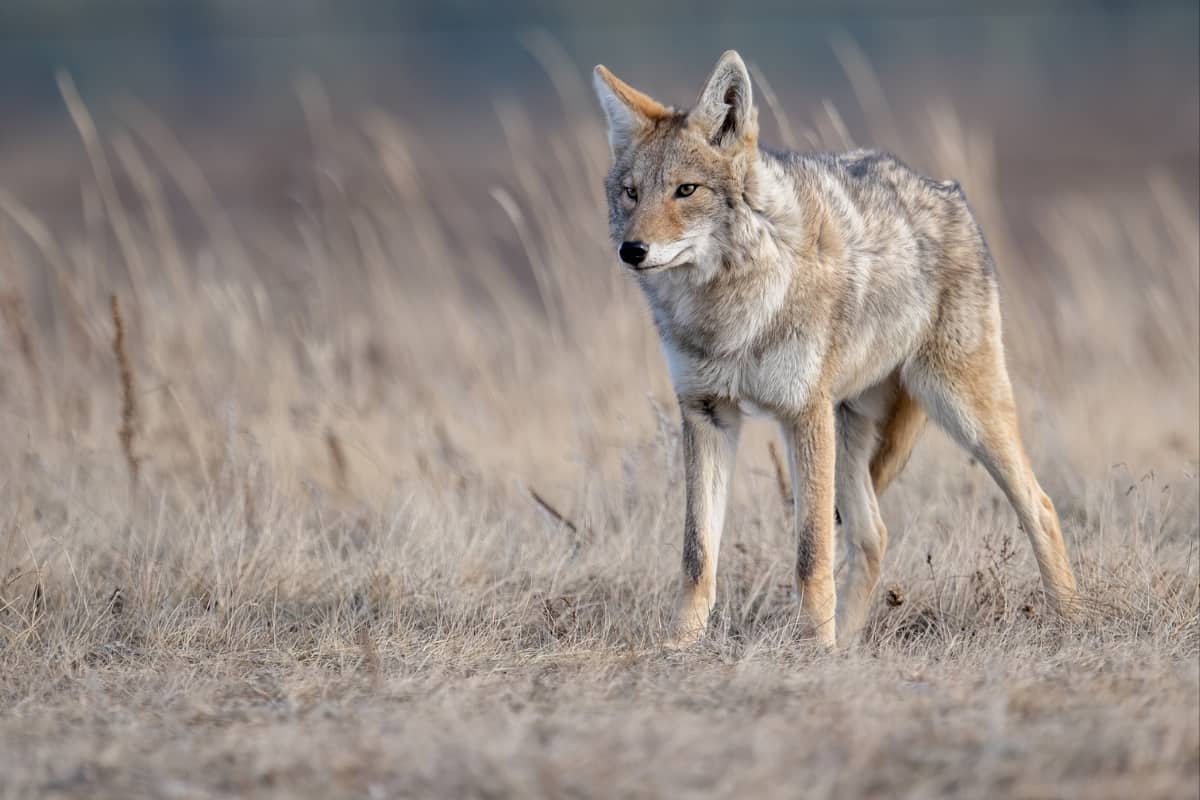
Coyote trapping has far-reaching implications on both the environment and ethical considerations surrounding wildlife management. Understanding the ecological role of coyotes and the ethical implications of trapping is vital for responsible and sustainable coyote management.
Evaluating the Role of Coyotes in the Ecosystem
Coyotes play a crucial role in maintaining ecological balance within their habitats. As opportunistic omnivores, they help regulate prey populations, such as rodents and small mammals, which, in turn, contribute to the health of ecosystems. Controlling these prey populations prevents overgrazing and maintains the balance of plant communities.
Furthermore, coyotes scavenge on carrion, which aids in nutrient cycling and decomposition, influencing the availability of resources for other wildlife species. Their presence influences predator-prey dynamics, leading to diverse and resilient ecosystems.
Ethical Considerations of Trapping
Ethical concerns arise when considering the welfare of individual animals and the impact on the overall coyote population. Trapping methods must prioritize the humane treatment of trapped animals, minimizing stress, pain, and suffering. Selecting appropriate trap types and checking traps regularly are essential steps to ensure ethical trapping.
Additionally, ethical dilemmas emerge concerning the necessity of trapping in specific situations. Human-wildlife conflicts and potential threats to human safety can justify trapping, but ethical considerations demand that trapping be conducted responsibly and as a last resort after exploring non-lethal alternatives.
Alternatives to Trapping

In some cases, non-lethal alternatives can be employed to address coyote conflicts and promote coexistence between humans and wildlife.
Coyote Deterrents and Prevention Methods
Using coyote deterrents and prevention methods can discourage coyotes from entering human-populated areas. These deterrents include motion-activated lights, noise-making devices, and visual deterrents, which create an unattractive environment for coyotes.
Coexistence Strategies with Wildlife
Promoting coexistence between humans and wildlife involves modifying human behavior and minimizing attractants that may draw coyotes closer to residential areas. Simple measures such as securing trash cans, removing food sources, and keeping small pets indoors during vulnerable times can reduce the likelihood of conflicts.
Coyote Conservation Efforts
Protecting coyotes and their habitats is essential for the overall health of ecosystems and biodiversity. Engaging in conservation efforts can help maintain a balanced and sustainable environment for all species.
Are coyotes endangered? Learn more about their conservation efforts.
Supporting Organizations Working for Coyote Protection
Numerous wildlife conservation organizations are dedicated to protecting coyotes and preserving their natural habitats. Supporting these organizations through donations, volunteering, or advocacy can contribute significantly to their conservation efforts.
Raising Awareness about Coyote Conservation
Raising awareness about the importance of coyotes in the ecosystem and dispelling myths and misconceptions surrounding them is essential for fostering positive attitudes towards these creatures. Education empowers communities to appreciate the ecological significance of coyotes and embrace coexistence strategies.
Conclusion
As you may have noted, in the above article we have not only discussed how to trap a coyote but also other aspects related to ethical and ecological considerations. These aspects are integral to coyote management and conservation rather than trapping them. Understanding the role of coyotes in the ecosystem highlights their importance as ecological regulators. Ethical trapping practices prioritize the welfare of individual animals while recognizing the necessity of responsible wildlife management.
In cases where trapping may not be the most appropriate solution, non-lethal alternatives and coexistence strategies can foster harmonious relationships between humans and coyotes. Contributing to coyote conservation efforts through supporting organizations and raising awareness ensures the preservation of these intelligent and adaptive creatures and the preservation of balanced ecosystems for future generations.
To cut a long story short, responsible and ethical approaches to coyote management are vital to achieving a harmonious coexistence between humans and wildlife while respecting the integrity of the natural world.


